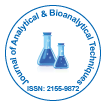Advances in Chiral Stationary Phases in Liquid Chromatography
Received: 24-Aug-2021 / Accepted Date: 09-Sep-2021 / Published Date: 16-Sep-2021 DOI: 10.4172/2155-9872.1000e002
Editorial Note
Derivatization represents an added step in the analysis of a sample and is justified only when it facilitates the isolation, separation, or detection of a compound or leads to more robust results by enhancing the stability of the compound, reduces matrix interferences improves the reproducibity of the method or simplifies the operational steps in the method. Many compounds lack a suitable chromophore, fluorophore, electrophore or possess low ionization efficiency for detection at anticipated sample concentrations. For compounds with reactive functional groups, simple chemical reactions allow the required detection characteristics to be acquired by the compound by modifying its chemical structure to that required for facile detection or serves to minimize matrix interference by moving the compound to a position in the chromatogram where interference in the detector response is minimal.
Replacing a reactive functional group with a substituent of different polarity and perhaps a relatively complex structure alters the separation charactieristics of the compound and if favourable might lead to an improvement in the separation but just as easily, might make the compounds more difficult to separate or extend the separation time. Individual reagents behave differently in this respect and a suitable reagent to enhance sample detection must also not lead to an inferior or unacceptable separation. Since derivatizing reactions can be performed either precolumn and effect the separation of the compounds or postcolumn and affect ony the detection step there is some flexibility in the selected approach. Occasionally, the derivatization reaction is performed close to the start of an isolation procedure to increase the selectivity of the method for the target compounds.
For precolumn derivatization the selected reaction must be quantitative or nearly so and free from by-products. Reaction conditions can usually be optimized free of time constraints. When possible, samples are processed in batches with a high level of automation and control of the reaction conditions but this can also be performed manually or for individual samples. Ingeneral a simple method must be available to separate excess reagent and other products from the derivatives if these interfere in their separation or detection. This is quite likely if the reagent and derivative share a common core structure responsible for the detector response.
Equipment for precolumn dervatization is relatively simple, typically glass tapered reaction vials or culture tubes with polytetrafluoroethylene-lined screw caps. Since only small sample sizes are required for analysis by liquid chromatography reaction vessels typically have volumes and common apparatus used for organic synthesis is rarely used. Reaction solutions are mixed by hand agitation, vortex mixing or with miniature polytetra flouroethylene coated stirring paddles driven by a magnetic stirrer. Slow reactions are usually accelerated by heating the reaction mixture with a convection oven, hotplate or drilled block heater. Microwave heating is being used increasingly to accelerate reaction rates and increase product yield and ultrasound radiation to accelerate reactions employing milder conditions. Automated equipment is available for laboratories that run routine methods incorporating derivatization reactions. Strategies for achieving greener dervitization procedures with an emphasis on less hazardous reagents and solvents and more efficient forms of energy coupling is a further recent trend.
Citation: Ahmed R (2021) Advances in Chiral Stationary Phases in Liquid Chromatography. J Anal Bioanal Tech 12: e002. DOI: 10.4172/2155-9872.1000e002
Copyright: © 2021 Ahmed R. This is an open-access article distributed under the terms of the Creative Commons Attribution License, which permits unrestricted use, distribution, and reproduction in any medium, provided the original author and source are credited.
Select your language of interest to view the total content in your interested language
Share This Article
Open Access Journals
Article Tools
Article Usage
- Total views: 1288
- [From(publication date): 0-2021 - Dec 20, 2025]
- Breakdown by view type
- HTML page views: 684
- PDF downloads: 604
